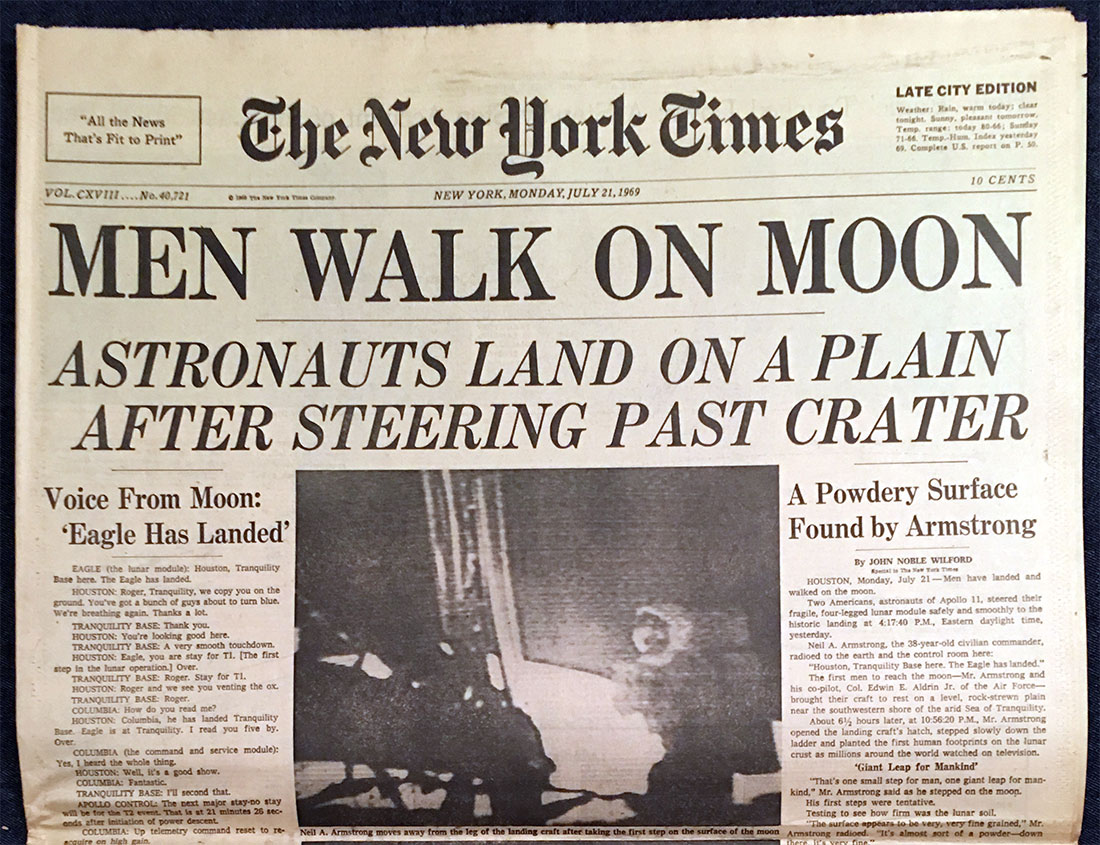Summer of ’69, Part III: The Moon Landing
What may have been the most important moment in human history occurred 20 July 1969, when Man first set foot upon the moon. NASA’s Apollo space program, designed to accomplish this astounding feat of ingenuity, technology, mathematics and physics, was conceived during the Eisenhower administration, but not constituted until President John F. Kennedy’s stirring address to Congress in 1961, where he proposed a national goal, “before this decade is out, of landing a man on the Moon and returning him safely to the Earth.”
Amazingly, the first crewed flight for the Apollo program occurred just the year before the successful landing, and within three years the last man had walked on the moon. Apollo 11’s three-man crew consisted of Neil Armstrong, the first to set foot on the lunar soil, Edwin “Buzz” Aldrin, who piloted the lunar lander and also walked on the surface, and Michael Collins, who remained in orbit to pilot the spacecraft.
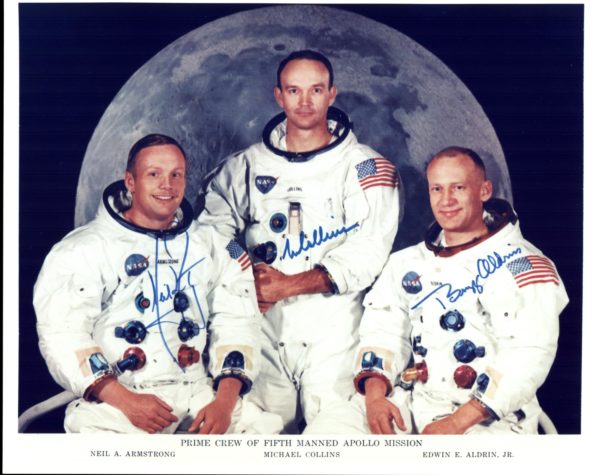
The Apollo 11 crew: left to right, Neil Armstrong, Michael Collins and Buzz Aldrin; asteroids Armstrong and Buzzi are T-Squared with the Sun for the landing, with Collins trine the Moon
I’m not sure about the logistics of erecting a horoscope for a non-terrestrial event, but the chart we’ll use is cast for 4:18 PM CDT on 20 July 1969, at Mission Control in Houston, Texas (Rodden Rating A). The efficacy of that chart emerges immediately upon inspection, for it has adventurer Mars exact on the exploration-oriented 2 Sagittarius Ascendant, squared to asteroid Apollo at 4 Virgo, on the 11 Virgo MC. As that Apollo placement implies, as the highest elevated point in the chart, the mission was the focus of all eyes in that moment. Neptune, representing the vastness and isolation of space, also conjoins the Ascendant from 26 Scorpio, and is exactly opposed asteroid Houston, operational HQ for the mission, conjunct the Descendant from 26 Taurus. These interact with a Sun/Mercury/TNO Logos conjunction at 27, 25 and 24 Cancer respectively, by trine and sextile, which represents the focus of the day (Sun), the news of the day (Mercury), and the rational mind which made it all possible (Logos).
Further evidence of the chart’s applicability is that its Horizontal Axis is an exact reverse of Neil Armstrong’s (born 12:31 AM EST 5 August 1930, Wapakoneta, OH; Rodden Rating AA), with his Ascendant at 2 Gemini and Descendant at 2 Sagittarius. Armstrong’s natal asteroid Houston at 26 Leo fills in a precise T-Square with the landing’s Neptune/Houston opposition.
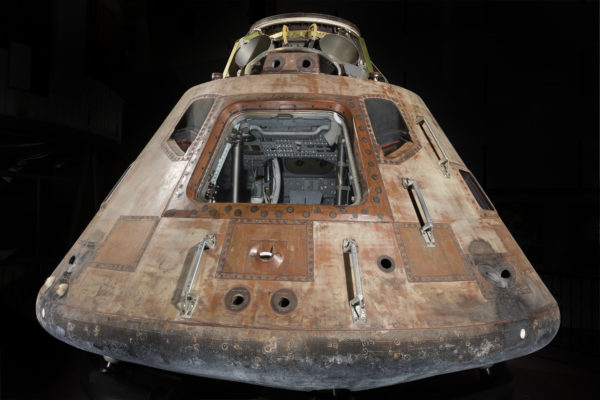
Apollo 11 Command Module “Columbia”, which took the trio safely to the moon and back; asteroid Columbia squares the Moon
All three Apollo 11 crewmembers have asteroids named for their surnames, as does the NASA space agency. Asteroid Armstrong appears at 25 Aries, opposing asteroid Buzzi (for “Buzz Aldrin) and NASA at 23 and 27 Libra, all T-Squared the solar stellium. Asteroid Aldrin at 1 Cancer closely squares an exact Jupiter/Uranus conjunction at 0 Libra, indicating fame or renown (Jupiter) via space flight (Uranus). Asteroid Collins at 15 Aquarius is sesquiquadrate Jupiter/Uranus, as well as conjoining asteroid Karma (a fated role to play) at 12 Aquarius and Edwin (“Buzz” Aldrin’s given first name) at 11 Aquarius, squared asteroid Neally (for Neil), which is stationary at 16 Scorpio, having turned direct two weeks prior at that same degree. Neally’s stationary status shows Armstrong as pivotal to the day, an embedded factor with a disproportionately large influence, which he fulfilled as the first man on the moon, or as he described it upon emerging from the lunar module six hours later: “one small step for man, one giant leap for mankind.”
The Moon herself is part of the Jupiter/Uranus pairing, from 8 Libra, also squaring Aldrin, trine Edwin and Collins, and squaring asteroid Columbia, the name of the Command Module, at 12 Cancer. This is astrologic poetry, with Uranus representing the flight itself and the technology to accomplish it, Jupiter ruling long voyages, and the Moon their destination. There’s a secondary connection to this Jupiter/Moon linkage as well – Jupiter rules eagles, and the famous phrase “The Eagle has landed” refers to the lunar module’s touchdown on the surface. In Armstrong’s chart, that 8 Libra degree conjoins a natal combination of asteroids Apollo and NASA, at 2 and 11 Libra, combining the name of the program and the agency that sponsored it, and opposes Uranus at 15 Aries, which is also at station, making space flight a vital element of Armstrong’s biography.
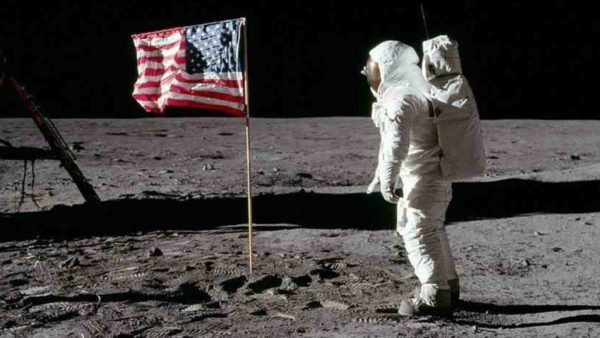
Neil Armstrong plants his country’s flag on the moon; asteroid Neally was stationary at the time, marking the period as significant for Armstrong
Also with Jupiter/Uranus is asteroid Icarus at 27 Virgo, exactly sextile the Sun, another allusion to flight which also indicates the risk involved in the enterprise. Armstrong has Icarus at station in his nativity (turning direct three days before his birth), making him an ideal candidate to accept that risk; at 9 Sagittarius, Icarus trines the 12 Leo Sun and conjoins the Descendant, making it a self-defining trait (Sun) and giving it angular force as well. Note also that Armstrong’s Sun is exactly opposed by transit Karma for the landing – this is his moment, predestined from birth.
Armstrong has a third point at station – asteroid Aldrin, which at 22 Sagittarius turned direct five days after his birth, identifying his close companion in this first-ever moon walk. In that light, it is no more than appropriate that Armstrong’s natal Aldrin should conjoin his Moon at 25 Sag, prefiguring their celestial connection, while their lunar proximity can be seen in transit Aldrin’s close conjunction from 1 Cancer with Armstrong’s natal Armstrong at 2 Cancer. Natal Moon/Aldrin is also in a Grand Trine with asteroids Neally at 25 Aries (just where Armstrong is at the landing!) and Houston at 26 Leo. This becomes a temporary Kite at the landing, with NASA at 27 Libra opposing Neally, directing the show and manifesting the Grand Trine’s inherent potential.

The Lunar Lander, which took Armstrong and Aldrin to and from the surface, named “the Eagle”; Jupiter rules eagles, and was conjunct the Moon for the landing
Asteroids America and Buzzi at 4 and 9 Gemini conjoin Armstrong’s 2 Gemini Ascendant, further validating the importance of the man who joined him in that first moon walk, and the country under whose banner he went there, both defining features of his public image (Ascendant). Natal asteroid Edwin, Buzz Aldrin’s legal first name, conjoins Armstrong’s Sun from 3 Leo, and the IC at 9 Leo, again suggesting a prime importance in his life.
We might describe this conglomeration of astrologic enmeshment by modifying the discipline’s guiding dictum: “As Above, So Below (as well as In Between)”.
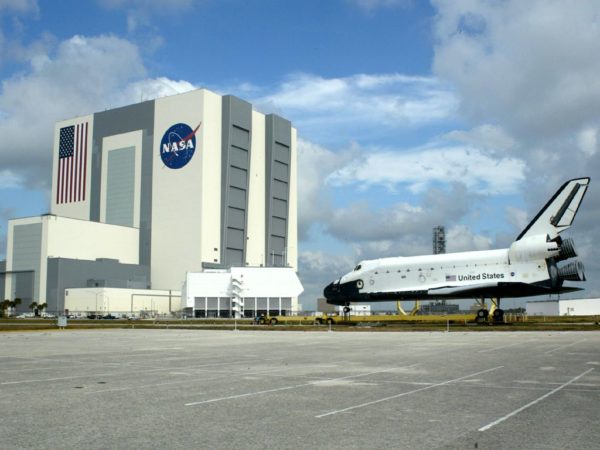
NASA’s Mission Control center in Houston, the brain and heart of the operation; asteroid NASA is exactly squared the Sun
Although the US abandoned manned lunar missions just three years later, the technological advances wrought by this endeavor continue to impact the world today, and the Apollo program laid the groundwork for more far-flung space exploration still to be undertaken in the future. As the first time our species slipped the surly bonds of earth and ventured boldly into extraterrestrial environments, it remains a watershed event for us all.
